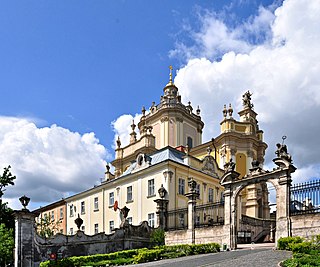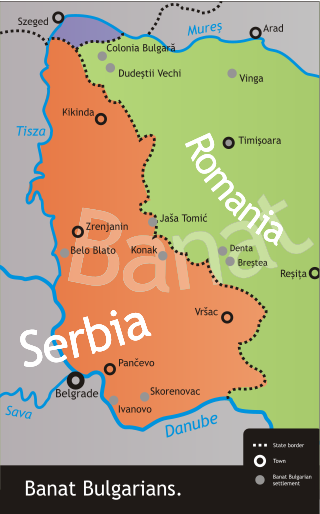
The Ukrainian Greek Catholic Church (UGCC) is a major archiepiscopal sui iuris ("autonomous") Eastern Catholic church that is based in Ukraine. As a particular church of the Catholic Church, it is in full communion with the Holy See. It is the second-largest particular church in the Catholic Church after the Latin Church. The major archbishop presides over the entire Church but is not distinguished with the patriarchal title. The incumbent Major Archbishop is Sviatoslav Shevchuk.

The Armenian Catholic Church is an Eastern Catholic particular churches sui iuris of the Catholic Church. It accepts the leadership of the bishop of Rome, and is therefore in full communion with the universal Catholic Church, including the Latin Church and the 22 other Eastern Catholic Churches. The Armenian Catholic Church is regulated by Eastern canon law, summed up in the Code of Canons of the Eastern Churches.

The Romanian Greek Catholic Church or Romanian Church United with Rome is a sui iuris Eastern Catholic Church, in full union with the Catholic Church. It has the rank of a Major Archiepiscopal Church and it uses the Byzantine liturgical rite in the Romanian language. It is part of the Major Archiepiscopal Churches of the Catholic Church that are not distinguished with a patriarchal title.

The Bulgarian Orthodox Church, legally the Patriarchate of Bulgaria, is an autocephalous Eastern Orthodox jurisdiction based in Bulgaria. It is the first medieval recognised patriarchate outside the Pentarchy and the oldest Slavic Orthodox church, with some 6 million members in Bulgaria and between 1.5 and 2 million members in a number of other European countries, Asia, the Americas, Australia, and New Zealand. It was recognized as autocephalous in 1945 by the Ecumenical Patriarchate of Constantinople.

Belene is a town in Pleven Province, Northern Bulgaria. It is the administrative centre of the homonymous Belene Municipality. The town is situated on the right bank of the Danube river, close to the town of Svishtov.

The Catholic Church in Georgia, since the 11th-century East–West Schism, has been composed mainly of Latin Church Catholics; a very large community of the Armenian Catholic Church has existed in Georgia since the 18th century.
Paulicianism was a medieval Christian sect which originated in Armenia in the 7th century. Followers of the sect were called Paulicians and referred to themselves as Good Christians. Little is known about the Paulician faith and various influences have been suggested, including Gnosticism, Marcionism, Manichaeism and Adoptionism, with other scholars arguing that doctrinally the Paulicians were a largely conventional Christian reform movement unrelated to any of these currents.

The Banat Bulgarians, also known as Bulgarian Roman Catholics and Bulgarians Paulicians or simply as Paulicians, are a distinct Bulgarian minority group which since the Chiprovtsi Uprising in the late 17th century began to settle in the region of the Banat, which was then ruled by the Habsburgs and after World War I was divided between Romania, Serbia, and Hungary. Unlike most other Bulgarians, they are Roman Catholic by confession and stem from groups of Paulicians and Roman Catholics from modern northern and northwestern Bulgaria.

The Catholic Church in Albania is part of the worldwide Catholic Church, under the spiritual leadership of the Pope in Rome.

The Catholic Church in Ukraine is part of the worldwide Catholic Church, under the spiritual leadership of the Pope in Rome. Catholics make up 10% of the population of Ukraine.

The Italian Catholic Church, or Catholic Church in Italy, is part of the worldwide Catholic Church in communion with the Pope in Rome, under the Conference of Italian Bishops. The pope serves also as Primate of Italy and Bishop of Rome. In addition to Italy, two other sovereign states are included in Italian dioceses: San Marino and the Vatican City. There are 225 dioceses in the Catholic Church in Italy, see further in this article and in the article List of Catholic dioceses in Italy.

The Catholic Church in Haiti is part of the worldwide Catholic Church, under the spiritual leadership of the pope, the Curia in Rome and the Conference of Haitian Bishops.

The Catholic Church in North Macedonia is part of the worldwide Catholic Church, under the spiritual leadership of the Pope in Rome and is one of the major religious communities that exist on the territory of the Republic of North Macedonia. Catholic believers from North Macedonia mostly include Albanians, Macedonians and Croats and are most concentrated in the Skopje Statistical Region and the Southeastern Statistical Region of North Macedonia.

The Bulgarian Greek Catholic Church is a sui iuris ("autonomous") Eastern Catholic church based in Bulgaria. As a particular church of the Catholic Church, it is in full communion with the Holy See. The Church's liturgical usage is that of the Byzantine Rite in the Bulgarian language. The Church is organised as a single eparchy — the Bulgarian Greek Catholic Eparchy of Sofia.
Armenians in Bulgaria are the fifth largest minority, after Russians, in the country, numbering 6,552 according to the 2011 census, down from 10,832 in 2001, while Armenian organizations estimate up to 80,000. Armenians have lived in the Balkans since no later than the 5th century, when they moved there as part of the Byzantine cavalry. Since then, the Armenians have had a continuous presence in Bulgarian lands and have often played an important part in the history of Bulgaria from early Medieval times until the present.

Religion in Bulgaria has been dominated by Christianity since its adoption as the state religion in 864. The dominant form of the religion is Eastern Orthodox Christianity within the fold of the Bulgarian Orthodox Church. During the Ottoman rule of the Balkans, Islam spread to the territories of Bulgaria, and it remains a significant minority today. The Catholic Church has roots in the country since the Middle Ages, and Protestantism arrived in the 19th century; both of them remain very small minorities. Today, a significant part of the Bulgarians are not religious, or believers who do not identify with any specific religion, and Bulgaria has been the cradle of some new religions, notably the Neo-Theosophical movement of Dunovism.

Romanian Catholics, like Catholics elsewhere, are members of the Catholic Church under the spiritual leadership of the Pope and Curia in Rome. The administration for the local Latin Church is centered in Bucharest, and comprises two archdioceses and four other dioceses. It is the second largest Romanian denomination after the Romanian Orthodox Church, and one of the 18 state-recognized religions. As of 2021, 5.2% of Romanians identified as Catholic. The 2012 census indicated that there were 741,276 Romanian citizens adhering to the Latin Church. Of these, the largest groups were Hungarians, Romanians, Germans and Slovaks.

The Catholic Church has a population in Kosovo of approximately 65,000 in a region of roughly 2 million people.

The Bulgarian Catholic Eparchy of Saint John XXIII of Sofia is an eparchy of the Bulgarian Greek Catholic Church which is a sui iuris ("autonomous") Eastern Catholic church based in Bulgaria. As a particular church of the Catholic Church, it is in full communion with the Holy See. The Church is organised as a single eparchy. Its liturgical usage is that of the Byzantine Rite in the Bulgarian language. It was elevated from an Apostolic Exarchate to a full eparchy by Pope Francis on 12 October 2019. The cathedral church of the eparchy is the Cathedral of the Dormition, in Bulgaria's capital Sofia.

The Cathedral of the Dormition, also called Cathedral of the Assumption of the Blessed Virgin Mary, is a Catholic church of Bulgarian (Byzantine) rite that is the mother church of the Bulgarian Greek Catholic Eparchy of Sofia, located in the city of Sofia, in Bulgaria.

















